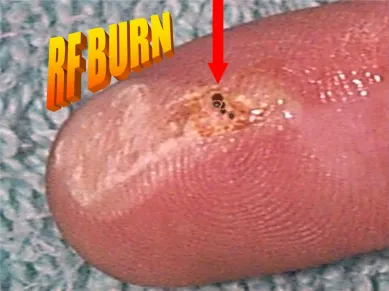Part 2 on Safety
Safety is an important topic in ham radio. There are 11 questions on electrical hazards in the USA Technician class license exam pool, 13 questions on tower safety and associated grounding, and 13 questions on radio frequency (RF) hazards.
Part 1 on general electrical hazards was posted previously. This post will address contact RF hazards. In case you are not familiar with the specifics of RF energy, refer to our post on the subject. A future post will cover the broad context of non-contact or indirect RF (radiation) safety. Both direct and indirect RF exposure will heat living tissue.

Here we are concerned about direct contact with a RF signal of significant energy. This might happen if a person or animal touches a conductor carrying RF energy. This most likely happens when someone touches an antenna element while the radio is transmitting. It’s painful…..as in, full of pain.

Another risk of RF contact is while working on live transmitter equipment or an antenna connector. It’s not hard to accidentally key the mic with your hands inside a transmitter enclosure or while touching an un-mated RF connector.
Human skin contact with live RF conductors is a painful experience above very low power levels. What makes it painful is that RF energy heats and damages tissue beneath the outer layer of skin, resulting in 2nd and 3rd degree burns. Not normally superficial, RF burns heal slowly.

Without going into physiological details, we will simply quote one person’s testimony: “For the first half-hour or so, all I could see was a tiny dot on my fingertip, and I didn’t think much of it. As the day went on, it hurt more and more, and by the end of the day there was a big, deep, dark blister that covered my entire fingertip and hurt like hell. It took weeks to heal.” There are some good references to RF burns at the end of this post, including a number of personal experiences.
There are a several factors involved in RF burns: Power level (available energy), contact surface area (more is better) , grounding/return contact (less is better) and radio frequency (the body absorbs more energy at certain frequencies).
How much power is needed to create a RF burn? Again, it varies. There are reports of people getting fingertip burns by touching the top of the antenna connector on a relatively low-power handheld VHF transceiver (5W) and keying the PTT button with no antenna screwed in. Obviously, a 100W HF transmitter can do much more damage than this. You don’t need to touch a 50kW AM broadcast antenna to get a nasty RF burn.
Treatment of RF burns are just like any other type– run cold water over it and/or ice it and seek medical attention. Avoidance is the best defense. Of course, most RF burns are unintentional so the best we can do is make you aware. Stay safe!
Direct RF burns cause more immediate tissue damage than indirect radiation but there is a hazard with both; be looking for a future posting in indirect RF hazards.
RF burn references
Forum with several detailed experiences reported
eHam My Very First RF Burn! interesting with experiences of many hams
EEVblog forum how does RF feel/taste? how about rf injury?
Compilation of various research studies
Biological effects of RF energy

